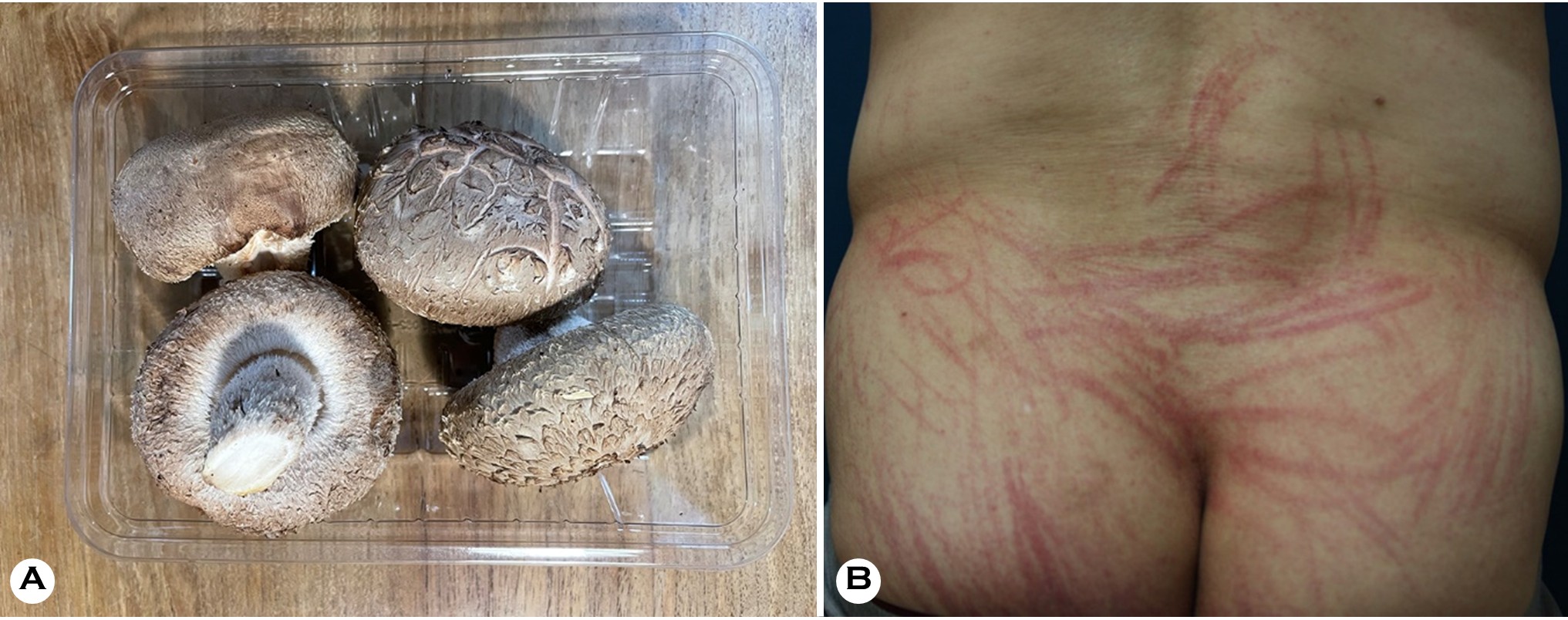pISSN : 3058-423X eISSN: 3058-4302
Open Access, Peer-reviewed

pISSN : 3058-423X eISSN: 3058-4302
Open Access, Peer-reviewed
Joonsoo Park
10.17966/JMI.2025.30.1.35 Epub 2025 April 01
Abstract
Keywords
Flagellate dermatitis Lentinan Mushroom Shiitake
Fungi can cause diseases in humans primarily through direct infection or the production of toxic substances. However, depending on the species, fungi can also trigger allergic re- actions, hypersensitivity responses, or irritant reactions that lead to health issues. One such condition is Mushroom Induced Flagellate Dermatitis.
This condition most commonly occurs after consuming shiitake mushrooms (Lentinula edodes, Fig. 1A) and is there- fore also known as Shiitake Dermatitis1. However, similar reactions have been reported after consuming other edible mushrooms, such as king oyster mushrooms and oyster mushrooms2. This is often due to crossbreeding during the cultivation process, where shiitake mushrooms are grafted onto other species to enhance flavor.

Shiitake mushrooms belong to the Basidiomycota phylum, Agaricomycetes class, Agaricales order, and Marasmiaceae family1,2. Mushroom Induced Flagellate Dermatitis is most frequently reported in East Asia, where shiitake mushrooms are a staple ingredient and are often eaten raw or under- cooked to retain their unique taste. Consequently, most cases occur during the spring months (March to May), when these mushrooms are cultivated and harvested2.
Symptoms typically appear 2~3 days after ingestion and include generalized pruritus, followed by the development of characteristic linear erythema (Fig. 1B)—reddish streaks resembling whip marks on scratched areas1,2. This reaction is believed to be caused by lentinan and other structurally similar polysaccharides found in shiitake mushrooms3. These compounds may trigger immune hypersensitivity or photo- sensitive inflammatory responses, leading to the release of inflammatory cytokines3.
Treatment is generally symptomatic, with patients showing improvement through supportive care1,2. This dermatitis can be prevented by ensuring that shiitake mushrooms are fully cooked, which alters the structure of the causative compounds and reduces the risk of reaction3.
With the growing popularity of Korean and Japanese cuisine, which often includes raw or lightly cooked mush- rooms, the cases of Mushroom Induced Flagellate Dermatitis have been increasing worldwide. While initially concentrated in East Asia, this condition is now being reported in other parts of the world, which highlights the need for increased awareness and caution when consuming undercooked mush- rooms.
References
1. Nakamura T. Shiitake (Letinus edodes) dermatitis. Contact Dermatitis 1992;27:65-70
Google Scholar
2. Ha JH, Byun DG, Kim SM, Yoo CH, Park CJ. Shiitake dermatitis in Korea; Clinical and histopathologic study. Korean J Dermatol 2003;41:440-444
Google Scholar
3. Tarvainen K, Salonen JP, Kanerva L, Estlander T, Keskinen H, Rantanen T. Allergy and toxicoderma from shiitake mushrooms. J Am Acad Dermatol 1991;24:64-66
Google Scholar
Congratulatory MessageClick here!